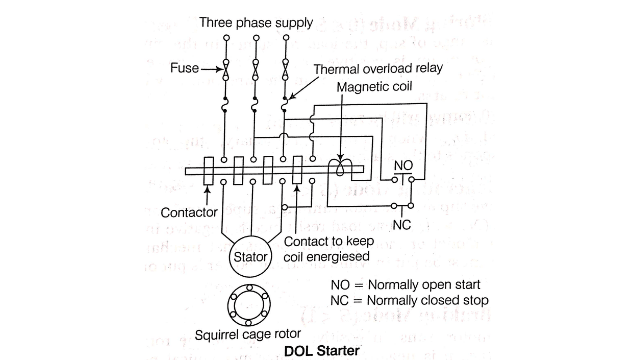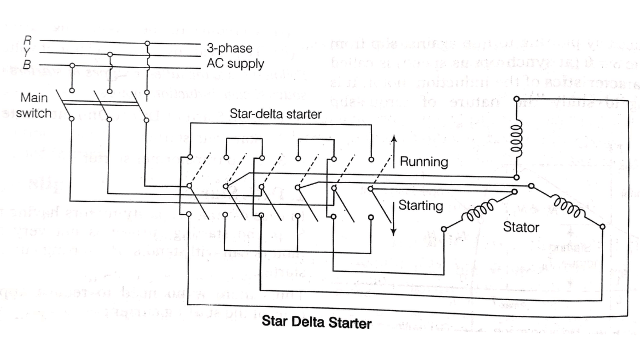
Table of Contents
Starting Methods of 3-Phase Induction Motor
Small induction motors up to 5 H.P may directly be switched on to the supply mains, but those motors which have large capacity needs a starting methods/starter to start the motor. In starting the motor induces a high starting so to limit the starting current which is 5 to 10% of full load current we use starters.
A rotating magnetic field is created when the supply is connected to the stator of a three-phase induction motor, and the rotor begins to rotate. As a result, a three-phase induction motor can start by itself. The motor slip is unity at beginning, and the starting current is very high. The purpose of a starter is not to start the motor as the name implies.
The motor’s starter perform mainly two functions.
1. To decrease the high initial current.
2. To protect against overload and under-voltage.
Types of Starter for 3-Phase Induction Motor
The common methods used for starting 3-phase induction motor are
- DOL Starter (Direct-On-Line Starter)
- Star-Delta starter
- Autotransformer starter
- Stator resistance starting
- Rotor resistance starting
Mainly we uses below three starter to start the 3-phase induction motors .
1. DOL Starter (Direct-On-Line Starter)
The starting current of small capacity motors with a rating of less than 5 HP is not very high, and these motors can withstand such a starting current without the use of a starter. As a result, no reduction in applied voltage is required to control the starting current. These motors use a special starter that connects the stator directly to the supply lines without reducing the voltage.
As a result, the starter is termed to as a direct-on-line starter. This starter is used to protect the motor from various severe abnormal conditions such as overloading, low voltage, single phasing, and so on, even though it does not reduce the applied voltage. The figure below shows the arrangement of various components in direct-on-line starter.

The NO contact is normally open and NC is normally closed. At start, NO is pushed for fraction of second due to which, coil gets energised and attracts the contactor. So, stator directly gets supply. The additional contact provided, ensures that as long as supply is ON, the coil gets supply and keeps contactor in ON position. When NC is pressed, the coil circuit gets opened due to which coil gets de-energised and motor gets switched OFF from the supply.
When the motor is overloaded, the current drawn by the motor increases, causing excessive heat to be produced, which raises the temperature to beyond levels. Thermal relays open when the temperature rises above a certain level, protecting the motor from overload.
2. Star-Delta starter
If the stator winding of the motor is directly connected with the supply, it will draws a high current. To control this high current, star-delta starter is used. A star-delta starter is used for a cage motor designed to run normally on delta connected stator winding. A star-delta starter is used with a squirrel cage induction motor having a capacity upto 5 HP. It is operated by a handle. In start position i.e., downwards, the stator windings are connected in star. The voltage on each winding will be equal to the line voltage √3 i.e., 57.7% of the line voltage.

When the rotor gains speed, the starter is quickly changed to run position i.e., upwards, thereby connecting the stator windings in delta. In delta, the phase voltage is equal to the line voltage, therefore, full line voltage is applied to the stator winding and the motor will run at its normal speed.
3. Autotransformer starter
This starter is used for starting the squirrel cage induction motors having a capacity of 25 or more than 25 HP. A three-phase autotransformer with many tapping in each winding is used in it as shown in figure.

Three leads are taken from the motor’s winding and connected to the stator. Reduced voltage is applied to the stator winding of the motor through these tappings when the motor is started.
The motor is run at a low speed, which reduces the current drawn by the motor. When the motor reaches about 75% of its maximum speed, the handle is moved to the run position, and the motor receives direct power. The auto transformer is out of circuit when in the running position. Coils for no-volt and over-load are included with this starter.
Read Also :-
Frequently Asked Questions (FAQs)
Why do we use a starter for an induction motor?
A three phase induction motor is a self starting motor because it produces it’s own starting torque. Thus, it can be used without a starter, but it is recommended to use that to reduce the initial high current, produce a higher starting torque, or for safety purposes.
Can we use a starter for a single-phase induction motor?
Fill the correct answer of this question in comment section…







Comments (1)
Nice content for students👍👍👍